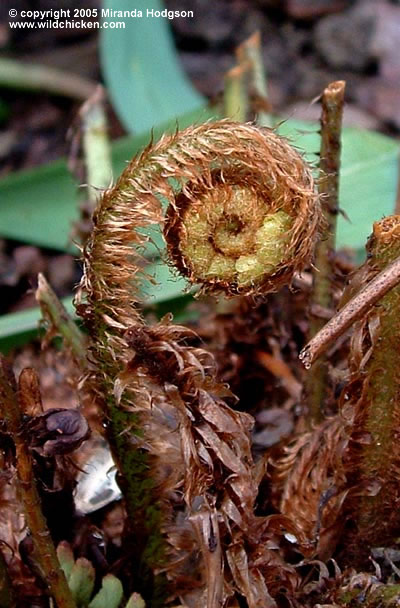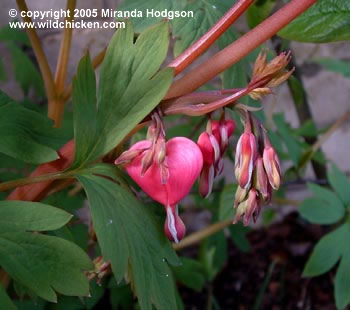6th April 2005 - Come on Spring - get on with it!
As decided last week, I planted a couple of Lavenders in front of the Dogwoods Ė ĎHidcoteí and ĎMunsteadí. Both had many fresh green new shoots, with a promise of scent and flowers to come. But then Ė outrage! Ė down came a starling, which carefully nipped off every single new shoot and carried them away. Iíve since read that starlings will take flowers and scented foliage for their nests but it isnít clear whether they do it for pest control or for some other reason. Whatever the motive, this one was impressively quick to find our plants.
"...Stipa tenuissima, especially, was reduced to small green hedgehog-like mounds by industrious sparrows..."
The grasses have so far avoided the devastation of previous springs when Stipa tenuissima, especially, was reduced to small green hedgehog-like mounds by industrious sparrows seeking nesting material. This year, after tidying up the grasses, we put out the collected trimmings, with a good amount of moss raked from the lawn, in a place where they will be easily found. From the kitchen window we can watch not only sparrows but tits, finches, robins and blackbirds coming down to gather up the carefully chosen selection and going away with their beaks full. Gazing sleepily at them in the early morning light is a gentle and lovely way to wake up.

The slugs are active again. It isnít so bad near the pond, now that we have four frogs patrolling the area, and Iíd have thought all the thrushes and blackbirds would keep the numbers down, but a couple of areas are showing more slug activity than Iíd like. To deal with this, an experiment has been put in progress and it will be interesting to see how it goes. Iím attempting to persuade the birds to pay more attention to the areas where they are needed by putting down tempting dainties to attract them. The idea is that they will discover the fat balls and slices of juicy apple in unexpected places, enjoy them and then look to see what else might be had which, of course, is the slugs and snails. With luck, all will benefit except the molluscs.
By chance, yesterday I came across a forum post where someone described how his father had worked as a gardener in his youth. Part of the young manís job was to put down apples for the very same reason that we are doing. Whilst not 100% effective, it is supposed to help control the situation. Fingers crossed, and updates to follow.

"Despite the spring being unable to decide on stopping or starting, the plants are romping away"
Despite the spring being unable to decide on stopping or starting, the plants are romping away. Those tiny green shoots of three weeks ago have suddenly become dense green mounds. Geranium endressii and G. phaeum especially have grown out considerably in the couple of weeks, almost doubling in size. G. endressii is rampant and will need cutting back more than once over the summer if it isnít to swamp other plants, but it is so pretty.
Along with the Geraniums, ferns are beginning to unfurl their fronds, Euphorbias are flowering and Osmanthus x burkwoodii is in full and fragrant bloom by the front door. Purple leaved Heuchera sanguinea ĎGeishaís Faní is uncurling flower stems and Pulmonaria officinalis is mottling the shade with the light of its pink, purple and blue flowers. Sedum spectabile, Spiraea japonica 'Goldflame' and Photinia x fraseri 'Red Robin' are all putting out masses of new foliage in grey/green, yellow, orange and red.

Dicentra spectabilis sprang up from the ground with surprising speed this year and has already begun to open its heart-shaped flowers, which hang so daintily from arching red tinged stems. It looks like it ought to be a tender plant, as if it would turn to a soggy mess at the first sign of cold, but is hardy down to -20įc.
"I have to say that itís a plant I tend to forget about once it finishes, then Iím pleasantly surprised when it reminds me of its existence in spring"
Whilst it benefits from some protection from chilling winds, part of its natural range covers East Asia, Northern China, Japan, Korea and Siberia, so we shouldn't be at all surprised that it survives our relatively mild winters. I have to say that itís a plant I tend to forget about once it finishes, then Iím pleasantly surprised when it reminds me of its existence in spring. The reason could be because it dies away to nothing before autumn begins, when so many other plants are still going strong, and is replaced in the forefront of my mind by the season's leaf colours, berry producers and late flowerers.
What a time spring is Ė all the long winter we yearn for it to begin, then as soon as the first shoots and flowers appear they put a smile on so many faces. But every year I forget the frustration of this season's waiting game and every year I try to be more patient. Although itís a thrill to see growth restarting, to see the first flowers and leaves, it seems to take so long for some things to happen. You see a leaf bud swelling and you think ĎGreat, thatíll open in a few daysí, but two weeks later itís hardly changed and you purse your lips and wonder if the plant has actually died in mid bud. I feel this now, so may as well do my usual early spring shout on-screen Ė ĎHey! HEY! Hellooooo! Iím ready!í
Spring? Did you hear me?
© Copyright Miranda Hodgson 2005